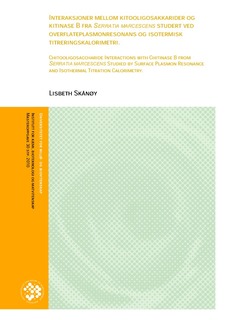Interaksjoner mellom kitooligosakkarider og kitinase B fra Serratia marcescens studert ved overflateplasmonresonans og isotermisk titreringskalorimetri.
Master thesis
Permanent lenke
http://hdl.handle.net/11250/186305Utgivelsesdato
2010-10-29Metadata
Vis full innførselSamlinger
- Master's theses (KBM) [890]
Sammendrag
Hovedmålet i dette studiet var å sammenligne bruk av isotermisk titreringskalorimetri (ITC)
og overflateplasmonresonans (SPR) ved bindingsstudier mellom KitinaseB(ChiB) og
kitooligosakkarider (KOS) av ulik lengde. Det ble utført forsøk med N-acetyl-D-glukosamin
((GlcNAc)3, (GlcNAc)4 og (GlcNAc)6) med ChiB-E144Q på Biacore. Det ble brukt to ulike
immobiliseringsmetoder av proteinet. De samme KOS ble også studert på ITC ved 18 °C.
Begge immobiliseringsmetodene ga samsvarende resultater med resultatene fra ITC. Det var
derfor mulig å kombinere informasjonen fra ITC og SPR til å gi et bilde av interaksjonene
mellom protein og ligand.
Resultatene fra SPR tyder på at assosiasjonsraten, ka, øker med økende substratlengde. Dette
er som forventet, da lengre substrater har flere gunstige interaksjoner med enzymet. Det ser ut
til at dissosiasjonsraten, kd, er uavhengig av substratlengden. Dette kan skyldes at dissosiasjon
av uspaltede oligomere domineres av det som skjer i -2 til +1 subsetene.
Neste mål var å kartlegge bindingsenergiene i de ulike subsetene hos ChiB. Ved å kombinere
resultatene fra denne studien med tidligere resultater for (GlcNAc)5 og ChiB-E144Q (Norberg
et al. 2010), var det mulig å beregne de ulike bindingsenergiene. Endringen i Gibbs fri energi
(ΔG) ble funnet til å være -0,2 kJ/mol, -22,8 kJ/mol, -8,0kJ/mol, -3,9 kJ/mol og -0,9 kJ/mol
for henholdsvis subsetene -3, (-2, -1 og +1), +2, +3 og ”+4”. Binding til subsetene -2, -1 og
+1 er hovedsakelig entalpisk drevet, mens binding i subsetene +2 og +3 er sterkt entropisk
drevet. VI
Abstract
The aim of this study was to compare the use of Isotermal Titration Calorimetry (ITC) and
Surface Plasmon Resonance (SPR) to do binding studies between Chitinase B (ChiB) and
chitooligosaccharides (CHOS) of different length. Experiments were performed with Nacetyl-
D-glucosamine ((GlcNAc)3, (GlcNAc)4 and (GlcNAc)6) with ChiB-E144Q on Biacore.
Two different methods of protein immobilization were used. The same CHOS were also
studied on ITC, at 18 °C. Both methods of immobilization gave good correspondence with the
results from ITC. This allows a combined interpretation of the data, giving a picture of
substrate binding in ChiB.
The results from SPR indicate that the association rate, ka, increases with increasing substrate
length. This is expected - as longer substrates have more favorable interactions with the
protein. It looks like the dissociation rate, kd, is independent of the substrate length. The only
way to explain this is that dissociation of the non-cleaved oligomers is dominated by what
takes place in the -2 to +1 subsites.
The next aim was to describe the binding energies in the individual subsites in ChiB. By
combining results from this study with previously observed results for (GlcNAc)5 (Norberg et
al. 2010), it was possible to calculate the binding energies. The change in Gibbs free energy
(ΔG) was found to be -0.2 kJ/mol, -22.8 kJ/mol, -8.0kJ/mol, -3.9 kJ/mol and -0.9 kJ/mol for
the subsites -3, (-2, -1 and +1), +2, +3 and ”+4”, respectively. Binding in the subsites -2, -1
and +1 are driven by enthalpy, whereas the binding in subsites +2 and +3 are driven by
entropy.
